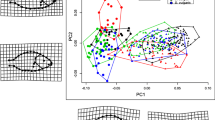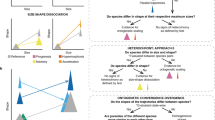Abstract
Developmental trajectories refer here to patterns of size and shape changes in ostracod valves during the sequence of post-embryonic growth stages. The information obtained from the study of such patterns has significant applications for evolutionary biology and/or (palaeo) ecology. Using geometric morphometrics methods, we describe the developmental trajectories of three ostracod species with valves retrieved from the sediments of lakes Mondsee (Austria), Hańcza (Poland) and Iseo (Italy). Size and shape data result in distinct developmental trajectories. Ontogenetic changes agree with predictions of Prizbram’s and Brooks’ laws. Patterns of valve shape change provide information which might be of use to the taxonomic definition of evolutionary lineages and to the development of studies of allometry and heterochrony in non-marine ostracods.
Similar content being viewed by others
References
Absolon, A. (1978): Die GattungCandona (Ostracoda) im Quartär von Europa. — Rada Matematicky a Prirodnich Ved,88: 1–72.
Alberch, P., Gould, S.J., Oster, G.F. &Wake, D.B. (1979): Size and shape in ontogeny and phylogeny. — Paleobiology,5: 296–317.
Alcorlo, P.;Baltanás, A. &Arqueros, L. (1999): Intra-clonal shape variability in the non-marine ostracod Heterocypris barbara (Crustacea, Ostracoda). — Geosound (Yerbilimleri),35: 1–11.
Baltanás, A., Otero, M., Arqueros, L., Rossetti, G.P. &Rossi, V. (2000): Ontogenetic changes in the carapace shape of the non-marine ostracodEucypris virens (Jurine). — Hydrobiologia,419: 65–72.
Baltanás, A., Brauneis, W, Danielopol, D.L. &Linhart, J. (2003): Morphometric methods for applied ostracodology: tools for outline analysis of nonmarine ostracods. — InPark, L.E. &Smith, A.J. (Eds): Bridging the gap, trends in the ostracode biological and geological sciences; The Paleontological Society Papers,9: 101–118.
Bookstein, F.L. (1991): Morphometric tools for landmark data: Geometry and Biology. — 1–435; New York (Cambridge University Press).
Brauneis, W., Linhart, J., Stracke, A., Danielopol, D.L., Neubauer, W. &Baltanás, A. (2006): — Morphomatica (Version 1.6.0) User Manual/Tutorial. — 1–82; Mondsee (Limnological Institute, Austrian Academy of Sciences), [download at: http://palstrat.uni-graz.at/morphomatica/morphomatica_e.htm]
Brooks, W.K. (1886): Report on the Stomatopoda dredged by H.M.S.“Challenger” during the years 1873 – 1876. — Report on the scientific results of the voyage of H.M. S.Challenger, Zoology,16: 1–116.
Clarke, K.R. &Gorley R.N. (2006): Primer v. 6: Computer program and User Manual/Tutorial. — 1–190; Plymouth (PRIMERE Ltd., Plymouth Marine Laboratory).
Danielopol, D.L. (1990): On the interest of the “Cytherissa” project and the present state of researches. — InDanielopol, D.L., Carbonel, P. &Colin, J.P. (Eds):Cytherissa theDrosophila of Paleolimnology, Bulletin de l’Institut de Géologie du Bassin d’Aquitaine,47: 15–26; Talence (Université de Bordeaux).
Danielopol, D.L., Ito, E., Wansard, G., Kamiya, T., Cronin, T. &Baltanás, A. (2002): Techniques for Collection and Study of Ostracoda, p. 65–97. — In:Holmes, J.A. &Chivas, A.R. (Eds) The Ostracoda, Application in Quaternary research. American Geophysical Union, Geophysical Monograph131: 65–97.
Dryden, I.L. &Mardia, K.V. (1998): Sratistical Shape Analysis. — 1–347; Chichester (John Wiley & Sons)
Dyar, H.G. (1890): The number of molts of lepidopterous larvae. — Psyche,5: 420–422
Finlay, B.J., Esteban, G.F., Brown, S., Fenchel, T. &Hoef-Emden, K. (2006): Multiple cosmopolitan ecotypes within a microbial eukariote morphospecies. — Protist,157: 377–390.
Foote, M. (1995): Morphological diversification of Paleozoic crinoids. — Paleobiology,14: 387–400.
Foster, D.W. &Kaesler, R.L. (1988) Shape analysis. Ideas from Ostracoda. — InMcKinney, M.L. (Ed.): Heterochrony in Evolution, 53–69; New York (Plenum Press).
Fowler, G.H. (1909): The Ostracoda. Biscayan plankton collected during a cruise of H.M.S. Research, 1900. — Transactions of Linnean Society, Zoology,2nd Ser.,10: 219–336.
Geiger, W. (1990): Field and laboratory studies on the life cycle ofCytherissa lacustris (Sars) (Crustacea, Ostracoda) with special emphasis on the role of temperature. — Bulletin de l’Institut de Géologie du Bassin d’Aquitaine,47: 191–208.
Gould, S.J. (1977): Ontogeny and Phylogeny. — I-IX, 1–501; Cambridge, Mass. (The Belnap Press).
Grafenstein, U. von (2002): Oxygen-isotope studies of ostracods from deep lakes. — InHolmes, J.A. &Chivas, A.R. (Eds): The Ostracoda, application in Quaternary research. Geophysical Monograph,131: 249–266; Washington (American Geophysical Union).
Heip, C. (1976): The life-cycle of Cyprideis torosa (Crustacea, Ostracoda). — Oecologia24, 229–245.
Hessland, I. (1949): Investigations of the lower Ordovician ostracods of the Siljan district, Sweden. — Bulletin of Geological Institute Uppsala,33: 97–408.
Holmes, J.A. &Chivas, A.R. (Eds) (2002): The Ostracoda, Application in Quaternary research. Geophysical Monograph131: 1–313; Washington (American Geophysical Union).
Hounsome, M.V. (1975): The effects of water temperature on the growth and allometry ofEucypris virens (Jurine) (Ostracoda, Crustacea). Ph.D. Thesis. — 1–220; Manchester (University of Manchester).
Hunt, G. (2001): Mixture Model Analysis v. 1.31. Software program. — Chicago (Committee on Evolutionary Biology, University of Chicago)
Hunt, G. (2007): Evolutionary divergence in directions of high phenotypic variance in the ostracode genusPoseidonamicus. — Evolution,61: 1560–1576.
Hunt, G. (2007): Morphology, ontogeny and phylogenetics of the genusPoseidonamicus (Ostracoda: Thaerocytherinae). — Journal of Paleontology,81: 607–631.
Hunt, G. &Chapman, R.E. (2001): Evaluating hypothesis of instar-grouping in arthropods: a maximum likelihood approach. — Paleobiology,27: 466–484.
Iepure, S., Namiotko, T. &Danielopol, D.L. (2007): Evolutionary aspects within the species groupPseudocandona eremita (Vejdovský) (Ostracoda, Candoninae). — Hydrobiologia,585: 159–180.
Irizuki, T. &Sasaki, O. (1993) Analysis of morphological changes through ontogeny: generaBaffinicythere andElofsonella (Hemicytherinae). — InMcKenzie, K.G. &Jones, P.J. (Eds): Ostracoda in the Earth and Life Sciences, 335–350; Rotterdam (A.A. Balkema)
Kaesler, R.L. &Foster, D.W. (1988): Ontogeny ofBradleya normani (Brady): Shape analysis of landmarks. — InHanai, T., Ikeya, N. &Ishizaki, K. (Eds): Evolutionary biology of Ostracoda, 207–218. Tokyo & Amsterdam (Kodansha & Elsevier).
Kamiya, T. (1992): Heterochronic dimorphism ofLoxoconcha uranouchiensis (Ostracoda) and its implication for speciation. — Paleobiology,18: 221–236.
Kendall, D.G. (1977): The diffusion of shape. — Advances in Applied Probability,9: 428–430.
Kesling, R.V. (1951a): The morphology of ostracod molt stages. — Illinois Biological Monographs,21: 1–126.
Kesling, R.V. (1951b): Mechanical solution of formulas for growth rates. — Contributions from Museum of Paleontology University of Michigan,8 (10): 231–237.
Kesling, R.V. (1952): Doubling in size of ostracod carapaces in each molt stage. — Journal of Paleontology,26: 772–780.
Kesling, R.V. (1953): A slide rule for the determination of instars in ostracod species. — Contributions from Museum of Paleontology University of Michigan,11: 97–109.
Kesling, R.V. &Crafts, F.C. (1962): Ontogenetic increase in Archimedean weight of the ostracodChlamydotheca unispinosa (Baird). — American Midland Naturalist,68: 149–153.
Kesling, R.V. &Takagi, R.S. (1961): Evaluation of Przibram’s law for ostracods by use of the Zeuthen Cartesian-diver weighing technique. — Contribution from Museum of Paleontology University Michigan,17: 1–58.
Klingerberg, C.P. (1998): Heterochrony and allometry: the analysis of evolutionary change in ontogeny. — Biological Reviews,73: 79–123.
Kurata, H. (1962): Studies on the age and growth of Crustacea. — Bulletin of the Hokkaido Regional Fisheries Research Laboratory,24: 1–115.
Lestrel, P.E. (2000): Morphometrics for the Life Sciences; — 1–261; Singapore (World Scientific).
Lestrel, P.E. (Ed.) (1997): Fourier descriptors and their applications in Biology. — 1–466; Cambridge (Cambridge University Press).
MacLeod, N. (1999): Generalizing and extending the eigenshape method of shape space visualization and analysis. — Paleobiology,25: 107–38.
Majoran, S., Agrenius, S. &Kucera, M. (2000): The effect of temperature on shell size and growth rate inKrithe praetexta (Sars). — Hydrobiologia,419: 141–148.
Maness, T.R. &Kaesler, R.L. (1987): Ontogenetic changes in the carapace ofTyrrhenocythere amnicola (Sars) a hemicytherid ostracode. — The University of Kansas Paleontological Contributions,118: 1–15.
Marín, J.A. (1984) Estudio del desarrollo de los ostrácodosEucypris aragonica y Heterocypris salina en cultivo de barro. — Limnetica,1: 345–354.
Martens, K. (1983): Aspects of the biology ofMytilocypris henricae (Chapman) (Crustacea, Ostracoda) with particular emphasis on salinity tolerance, life history and postembrional ontogeny. — M. Sc. Thesis; 1–235; Canberra (The Australian National University).
Martens, K. (1985): Effects of temperature and salinity on postembryonic growth inMytilocypris henricae (Chapman) (Crustacea, Ostracoda). Journal of Crustacean Biology,5: 258–272.
McGhee, G.R., Jr. (1999): Theoretical Morphology. — 1–316, New York (Columbia University Press).
McLellan, T. &Endler, J.A. (1998): The relative success of some methods for measuring and describing the shape of complex objects. — Systematic Biology,47: 264–81.
Meisch, C. (2000): Freshwater Ostracoda of Western and Central Europe. — 1–522; Heidelberg (Spektrum Akademischer Verlg., G. Fischer).
Mezquita, F., Olmos, V. &Oltra, R. (2000): Population ecology ofCyprideis torosa (Jones, 1850) in a hypersaline environment of the Western Mediterranean (Santa Pola, Alacant). — Ophelia,53: 119–130.
Minati, K.,Cabral, M.C.,Pipík, R.,Danielopol, D.L.,Linhart, J. &Neubauer, W. (2008): Morphological variability among European populations ofVestalenula cylindrica (Straub) (Crustacea, Ostracoda). — Palaeogeography, Palaeoclimatology, Palaeoecology. Doi: 10.1016/j.palaeo.2007.05.027.
Needham, A.E. (1950): The form-transformation of the abdomen of the female pea-crab,Pinnotheres pisumLeach. — Proceedings of Royal Society,B, 137: 115–136.
Neubauer, W. (2007): Measuring the difference of approximating B-spline curves with application in distinguishing Ostracoda. — MSc Thesis, Institute of Mathematics, University of Salzburg, http://palstrat.uni-graz.at/morphomatica/morphomatica_e.htm).
Park, L.E. &Smith, A.J. (Eds.) (2003): Bridging the gap, Trends in the Ostracode Biological and Geological Sciences; The Paleontological Society Papers,9: 1–290; New Haven (The Paleontological Society).
Przibram, H. (1931): Connecting laws in animal morphology. Four lectures held at the University of London. — 1–62; London (University London Press).
Przibram, H. &Megušar, F. (1912): Wachtstummessungen anSphodromantis bioculataBurm. 1. Länge und Masse. — Achiv für Entwickungsmechanik der Organismen (Wilhelm Roux),34: 680–741.
Ranta, E. (1979): Population biology ofDarwinula stevensoni (Crustacea, Ostracoda) in an oligotrophic lake. — Annales Zoologici Fennici16, 28–35.
Reyment, R.A. (1995): On multivariate morphometrics applied to Ostracoda. — InRiha, J. (Ed.): Ostracoda and biostratigraphy, pp. 43–48, Rotterdam (A.A. Balkema).
Reyment, R.A., Bookstein, F.L., McKenzie, K., &Majoran, G.S. (1988). Ecophenotypic variation inMitilus pumilus (Ostracoda) from Australia, studied by canonical variate analysis and tensor biometrics. — Journal of Micropalaeontology,7: 11–20.
Reyment, R.A. &Bookstein, F.L. (1993): Infraspecific variability in shape inNeobuntonia airella: an exposition of geometric morphometry. — InMcKenzie, K.G. &Jones, P.J. (Eds.): Ostracoda in the Earth and Life Sciences: 291–314; Rotterdam (A.A. Balkema).
Rohlf, F.J. (1990): Morphomettics. — Annual Review of Ecology and Systematics,21:299–316.
Rohlf, F.J. 2001.Tpsdig, Program version 1.43. Stony Brook (Department of Ecology and Evolution, State University of New York) [http://life.bio.sunysb.edu/morph/soft-dataacq.html].
Rohlf, F.J. &Archie, J.W. (1984): A comparison of Fourier methods for the description of wing shape in mosquitoes (Diptera: Culicidae). — Systematic Zoology,33:302–317.
Rudjakov, J.A. (1962): Some growth regularities of pelagic ostracods of the family Halocypridae. — Akademiya Nauk SSSR,58: 167–171.
Schweitzer, P.N. &Lohmann, G.P. (1990): Life-history and the evolution of ontogeny in the ostracode genus Cyprideis. — Paleobiology,16: 107–125.
Schweitzer, P.N., Kaesler, R.L. &Lohmann, G.P. (1986): Ontogeny and heterochrony in the ostracodeCapellinaCoryell from Lower Permian rocks in Kansas. — Paleobiology,12: 290–301.
Shaver, R.H. (1953): Ontogeny and sexual dimorphism inCytherella bullata. — Journal of Paleontology,27: 471–480.
Skosberg, T. (1920): Studies on marine ostracods. I. Cypridinids, halocyprids, and policopids. — Zoologiska Bidrag Uppsala,Suppl. 1: 1–782.
Smith, R.J. &Martens, K. (2000): The ontogeny of the cypridid ostracodEucypris virens (Jurine, 1820) (Crustacea, Ostracoda). — Hydrobiologia,419: 31–63.
Sohn, I.G. (1950): Growth stages in fossil ostracodes. — American Journal of Sciences,248: 427–434.
Sterelny, K. (1999): Species as ecological mosaics. — InWilson, R.A. (Ed.): Species: new interdisciplinary essays: 119–138; Cambridge, Mass. (The MIT Press).
Zelditch, M.L., Swiderski, D.L., Sheets, H.D. &Fink, W.L. (2004): Geometric morphometrics for biologists; a Primer. — 1–443; Amsterdam (Elsevier, Academic Press).
Author information
Authors and Affiliations
Corresponding author
Additional information
Dedicated to Prof. Dr. F. F.Steininger
Rights and permissions
About this article
Cite this article
Danielopol, D.L., Baltanás, A., Namiotko, T. et al. Developmental trajectories in geographically separated populations of non-marine ostracods: morphometric applications for palaeoecological studies. Senckenbergiana lethaea 88, 183–193 (2008). https://doi.org/10.1007/BF03043988
Received:
Accepted:
Issue Date:
DOI: https://doi.org/10.1007/BF03043988




